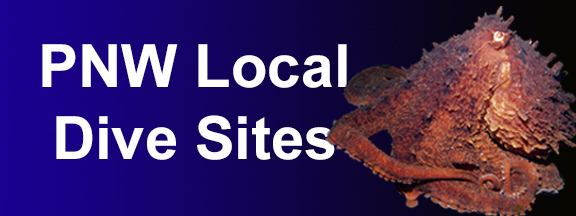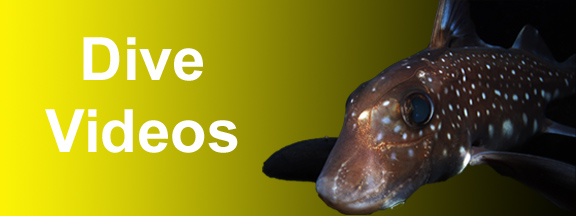

Gear
Gear
I am often asked about gear and gear configuration, especially by new divers. There are several schools of thought regarding gear and gear configuration, some that are extremely militant and other that allow for more flexibility. My advice is find gear that is comfortable and works well for you. Rig the gear in a sensible way and become very familiar and comfortable with that configuration. Keep things simple and don't continually change gear configurations. Being able to operate your gear quickly and properly in an emergency situation should be second nature. Having to pause and think "how did I rig my gear today" could turn an emergency into a catastrophe.
Scuba Equipment Vendors:
There are literally hundreds of scuba gear manufacturers in the world today. Although I do not officially endorse any particular manufacturers, I have had excellent experience with several that merits mention:
DUI: DUI is best known for their drysuits, but does make other gear. I switched from a shell drysuit to a crushed neoprene drysuit in 1999 and selected the DUI DF200X. Although expensive, this drysuit has proven to be very rugged and well designed. The telescoping torso allows the suit to fit me like a glove height wise, yet still allows me complete flexibility in the water. My original DUI has about 800 dives on it and is still going strong. I purchased a new suit in 2006 and didn't even consider another brand. Anytime I have had an issue with my suit, DUI has stepped up to the plate. The first time I sent my DUI back for a zipper replacement (which is about every 250 dives), they replaced the purge valve on my suit for free as there was an improvement in the valve design since I purchased the suit. From the outside, DUI appears to put diving and their customers first, business second.
OS Systems: Another drysuit company. My first drysuit was an OS Systems shell suit. OS Systems provided explempliary service with respect to this suit. After a year of use, I noted some slight discoloration on part of the suit. OS insisted that I send it back to them. I did, and they replaced the suit. The discoloration was purely cosmetic. I still use OS Systems latex seals, dryhood, and dryglove system today.
Ikelite: Makers of affordable underwater housing and excellent strobes. Ikelite's customer service and products are amazing. I have owned four Ikelite housings over my diving career, and all have worked extremely well. Anytime there is even the slightest issue with one of their products, they replace it. Ikelite had a design flaw with the sync cord that runs from the housing for the C-8080 to the strobe that caused the sync cord to bend unnecessarily and eventually break. Ikelite kept me in repaired sync cords for years, free of charge. I might add that they resolved this issue with my Canon 450D housing and adding a strain relief to the cord. Ikelite has also turned around some repairs in less than a day from receipt. Good people and good products.
Gear Configuration:
For what it is worth, my recreational gear configuration is as follows:
Drysuit: DUI CF200X crushed neoprene with front entry zipper and rock boots.
BCD: Halcyon SS backplate with Pioneer 45 pound lift wing. I have had this BC for 7 years. I developed a leak along a seam after 3 years of service, but Halcyon replaced it for free and it has been trouble-free ever since. This is not the most comfortable BC out of the water, but it is very simple and seems to disappear once in the water.
Fins: Scuba-pro Jet fins. Big, heavy, and hard to push compared to other fins. However they can move a ton of water quickly and provide excellent maneuverability, which is critical to me being a photographer. I travel with a set of much lighter Mares Quattro fins for tropical adventures.
Hood: OS System dryhood. Thanks to Jeff Christiansen for helping me get this set up. I can't believe how much warmer my core stays with a latex dryhood. Plus, you actually get stereo hearing back with a dryhood - and can even use your iPod underwater!
Gloves: OS Systems dryglove rings with Wells Lamont neoprene or Altas gloves ($6 a pair). Drygloves definitely allow for better dexterity when operating an underwater SLR camera.
Lighting: Lighting has come a LONG way in a very short amount of time. I started of with Underwater Kinetics C8 and D8R lights in the 90's, but quickly migrated to canister style HID lights by 2000. Although these lights were super bright, they were also super expensive ($800-$1400 for an 18w version) and super bulks, requiring a tethered canister. The advent of LED and Li-ion cells has revolutionized the dive light market. Today, I dive with two "Light-4-Me" mini 3XPG LED lights that output 1000 lumens, cost $80, are only 5" long, and give me an 80 minute burn on a single 18650 Li-Ion cell that I can buy for $10. If only the same progress could me made with scuba cylinders....
Cylinders: Faber steel cylinders. I love these cylinders - I have 7 of them. I also have 3 Genesis steel cylinders (distributed by Catalina Cylinders). The Genesis cylinders have been problematic - in both terms of rusting and metallic odor. Catalina did recently clean these cylinders for me for free and resolve the odor problem. However, the odor comes back after about a year. I use a Catalina 19 cu foot aluminum cylinder as my pony mounted to my primary tank with a Pony Tamer.
Computer: Suunto Vytek with hoseless air integration Nitrox computer. This is my second Vytek. The depth gauge on my first quit working after 7 years of service and close to 1000 dives. Up until that point, this computer had been reliable and very easy to use.
Regulators: I am currently diving an Atomic M1 as my primary. Although I like this reg now, I must say that I was very disappointed with it initially. This is a very expensive reg (MSRP $700), and it does not breath nearly as smoothly as my prior regs (Apek ATX200 and ATX50). If I was to do it over again, I would buy Apek. There is nothing wrong with the Atomic; it is a high quality well built reg - it is just not as smooth. I use an Apeks Egress for by pony bottle (which also breaths smoother than my Atomic). I typically use a long hose on my primary when buddy diving and an short hose when solo diving. A long hose makes any sort of buddy breathing ascents orders of magnitude easier and safer.
Mask: Cressi-sub Matrix and Horizon with black skirt. Low volume and absolutely phenomenal vision. When buying a mask, make certain whatever mask you select fits YOU and doesn't leak. I dove for the first two years with a mask that just slightly leaked. Not knowing any better, I just accepted it. What I revelation when I accidentally grabbed my wife's mask one day and it didn't leak at all!
Scuba Equipment Vendors:
There are literally hundreds of scuba gear manufacturers in the world today. Although I do not officially endorse any particular manufacturers, I have had excellent experience with several that merits mention:
DUI: DUI is best known for their drysuits, but does make other gear. I switched from a shell drysuit to a crushed neoprene drysuit in 1999 and selected the DUI DF200X. Although expensive, this drysuit has proven to be very rugged and well designed. The telescoping torso allows the suit to fit me like a glove height wise, yet still allows me complete flexibility in the water. My original DUI has about 800 dives on it and is still going strong. I purchased a new suit in 2006 and didn't even consider another brand. Anytime I have had an issue with my suit, DUI has stepped up to the plate. The first time I sent my DUI back for a zipper replacement (which is about every 250 dives), they replaced the purge valve on my suit for free as there was an improvement in the valve design since I purchased the suit. From the outside, DUI appears to put diving and their customers first, business second.
OS Systems: Another drysuit company. My first drysuit was an OS Systems shell suit. OS Systems provided explempliary service with respect to this suit. After a year of use, I noted some slight discoloration on part of the suit. OS insisted that I send it back to them. I did, and they replaced the suit. The discoloration was purely cosmetic. I still use OS Systems latex seals, dryhood, and dryglove system today.
Ikelite: Makers of affordable underwater housing and excellent strobes. Ikelite's customer service and products are amazing. I have owned four Ikelite housings over my diving career, and all have worked extremely well. Anytime there is even the slightest issue with one of their products, they replace it. Ikelite had a design flaw with the sync cord that runs from the housing for the C-8080 to the strobe that caused the sync cord to bend unnecessarily and eventually break. Ikelite kept me in repaired sync cords for years, free of charge. I might add that they resolved this issue with my Canon 450D housing and adding a strain relief to the cord. Ikelite has also turned around some repairs in less than a day from receipt. Good people and good products.
Gear Configuration:
For what it is worth, my recreational gear configuration is as follows:
Drysuit: DUI CF200X crushed neoprene with front entry zipper and rock boots.
BCD: Halcyon SS backplate with Pioneer 45 pound lift wing. I have had this BC for 7 years. I developed a leak along a seam after 3 years of service, but Halcyon replaced it for free and it has been trouble-free ever since. This is not the most comfortable BC out of the water, but it is very simple and seems to disappear once in the water.
Fins: Scuba-pro Jet fins. Big, heavy, and hard to push compared to other fins. However they can move a ton of water quickly and provide excellent maneuverability, which is critical to me being a photographer. I travel with a set of much lighter Mares Quattro fins for tropical adventures.
Hood: OS System dryhood. Thanks to Jeff Christiansen for helping me get this set up. I can't believe how much warmer my core stays with a latex dryhood. Plus, you actually get stereo hearing back with a dryhood - and can even use your iPod underwater!
Gloves: OS Systems dryglove rings with Wells Lamont neoprene or Altas gloves ($6 a pair). Drygloves definitely allow for better dexterity when operating an underwater SLR camera.
Lighting: Lighting has come a LONG way in a very short amount of time. I started of with Underwater Kinetics C8 and D8R lights in the 90's, but quickly migrated to canister style HID lights by 2000. Although these lights were super bright, they were also super expensive ($800-$1400 for an 18w version) and super bulks, requiring a tethered canister. The advent of LED and Li-ion cells has revolutionized the dive light market. Today, I dive with two "Light-4-Me" mini 3XPG LED lights that output 1000 lumens, cost $80, are only 5" long, and give me an 80 minute burn on a single 18650 Li-Ion cell that I can buy for $10. If only the same progress could me made with scuba cylinders....
Cylinders: Faber steel cylinders. I love these cylinders - I have 7 of them. I also have 3 Genesis steel cylinders (distributed by Catalina Cylinders). The Genesis cylinders have been problematic - in both terms of rusting and metallic odor. Catalina did recently clean these cylinders for me for free and resolve the odor problem. However, the odor comes back after about a year. I use a Catalina 19 cu foot aluminum cylinder as my pony mounted to my primary tank with a Pony Tamer.
Computer: Suunto Vytek with hoseless air integration Nitrox computer. This is my second Vytek. The depth gauge on my first quit working after 7 years of service and close to 1000 dives. Up until that point, this computer had been reliable and very easy to use.
Regulators: I am currently diving an Atomic M1 as my primary. Although I like this reg now, I must say that I was very disappointed with it initially. This is a very expensive reg (MSRP $700), and it does not breath nearly as smoothly as my prior regs (Apek ATX200 and ATX50). If I was to do it over again, I would buy Apek. There is nothing wrong with the Atomic; it is a high quality well built reg - it is just not as smooth. I use an Apeks Egress for by pony bottle (which also breaths smoother than my Atomic). I typically use a long hose on my primary when buddy diving and an short hose when solo diving. A long hose makes any sort of buddy breathing ascents orders of magnitude easier and safer.
Mask: Cressi-sub Matrix and Horizon with black skirt. Low volume and absolutely phenomenal vision. When buying a mask, make certain whatever mask you select fits YOU and doesn't leak. I dove for the first two years with a mask that just slightly leaked. Not knowing any better, I just accepted it. What I revelation when I accidentally grabbed my wife's mask one day and it didn't leak at all!











